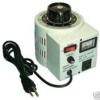Thanks for sharing Dale. I've been following the speed control topics for a while. Definitely understand how this is the preferred method of speed control without isolating the center rail. I'll be seeking your help soon when I get ready to install on our Christmas Polar Express Double Helix.
Originally Posted by Dale H:
A few people E mailed me on the circuit so here is a diagram for those interested.Click to enlarge.

Parts are 3, 25 amp bridge rectifiers used as voltage droppers the 3 shown will drop about 4 volts but more or less can be used. They can be tapped in .6 volt increments to obtained the desired drop.
5 diodes 1n4001. 4 of the diodes provide half wave DC rectification for the relay coil. They keep the 4 outside insulated rails separated electrically in case the outside rails on the curves are also used for block signals or similar purposes. more sections can be insulated for slow down in the same way for more complicated loops. The diode across the relay coil eliminates voltage spikes.
1, 470 uf or 1000 uf capacitor,35 volt or more. This charges DC to peak and prevents relay chatter.
1 relay SPDT with at least 10 amp contacts and a 24 VDC coil.
These parts can be had from www.allelectronics.com or similar electrical supply houses. Cost for all the parts would be maybe $25.
Shown hooked to a PWZW but any transformer with appropriate accessory taps can be used. 12 VDC coiled relays can be used with a 10 volt tap.
The train wheels on the curves connect the outside insulated rails to track common and energize the relay.
The contacts are wired so that if the relay coil is on the (when any car is on the insulated section) the track voltage is reduced by about 4 volts. When not occupied the track receives full voltage. Similar set ups can be used for uphill boost and down hill reduction in voltage.
PS2 engines in conventional run between about 8 and 18 volts. So if set on 16 volts,the train would run with full voltage on the straights and about 12 volts on the curves.. Center rails need not be insulated if only 1 train runs on the loop. Thus,there is no roller jumping problem,the advantage of using a relay.
Dropping voltage with diodes is explained in and earlier link.
Below in the middle of the pic is a voltage dropper made from diodes and rectifiers which is used as a complete throttle for automation,providing a 5-16 volt spread for track voltage for soft start. In the above circuit 3 bridge rectifiers should be enough. Click to enlarge.

Dale H
![]()







